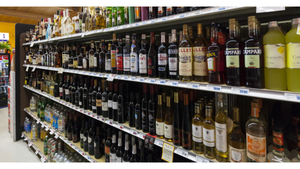FRESH THREAT
Terrorism has redefined the term "food poisoning" in more ominous terms.The range of possibilities -- from introducing foot-and-mouth disease into a healthy herd of cattle, to applying cyanide on bulk produce -- has been talked about and worried over, but until the Sept. 11 attacks in New York and Washington, the idea of deliberate tampering with fresh foods was a topic most people, understandably,
November 5, 2001
ROBERT VOSBURGH
Terrorism has redefined the term "food poisoning" in more ominous terms.
The range of possibilities -- from introducing foot-and-mouth disease into a healthy herd of cattle, to applying cyanide on bulk produce -- has been talked about and worried over, but until the Sept. 11 attacks in New York and Washington, the idea of deliberate tampering with fresh foods was a topic most people, understandably, were loathe to publicly address.
"Right now, our priority is communicating with our stores, and to work very closely with the state and local people and to start developing ties that we've never really had before, with fire and police officials," said Cas Tryba, manager of food safety for Big Y Foods, Springfield, Mass.
Communication is the primary goal of all retailers in the aftermath of the initial strike and subsequent anthrax scare. As Tryba spoke, he was preparing to represent Big Y at a fact-finding meeting between the business community and government, organized by the Connecticut Food Association.
"There's a hysteria out there among the public that the whole world is going to end because of this, and hundreds of businesses and hospitals and schools are being shut down," he told SN. "So, there certainly needs to be a protocol developed that promotes common sense in our response to these threats."
Like many other retailers, Tryba spoke from recent experience after a single Big Y store was closed for more than seven hours while emergency response personnel investigated possible anthrax contamination in the unit. The event was precipitated by a panicky phone call from a woman who had discovered a white, powdery substance in a magazine she had earlier purchased at the store.
Like all the other supermarket-related alerts to date, the incident turned out to be a false alarm. But a severe case of consumer anxiety continues to cast a pall over the business of selling food, and retailers are finding resources stretched and priorities rewritten.
"Retailers are up against store closures for something other than potentially contaminated food products," said Tryba. "That was an angle I never expected and all retailers are facing now -- people walking in and seeing a little bit of a white powder on a shelf or in a corner and calling the police and closing stores."
The evolving situation has caused all participants in the supply chain to re-evaluate their safeguards and to renew their commitment to food safety in all its guises. Industry watchdogs applaud the efforts, but caution that it's time to plug long-exposed loopholes in the system that can allow terrorists to slip through and do harm.
"Whether the problem is intentional food contamination by bioterrorists or unintentional contamination by a dirty food plant, our food-safety system is flawed," said Michael Jacobson, executive director of the Center for Science in the Public Interest, in testimony before Congress. "Weaknesses in our government programs could set the stage for a crisis in consumer confidence."
Government agencies and all segments of the food industry are banding together in an unprecedented, goodwill effort to protect the nation's food supply from malicious actions. The multifaceted initiative walks a fine line that implements upgraded security measures, but doesn't unduly alarm the already-skittish American consumer.
The industry felt a twinge of public apprehension just this past summer, when Europe was besieged with outbreaks of foot-and-mouth disease and BSE that crossed borders with alarming speed, requiring wholesale slaughter of livestock and causing a public outcry for stronger food-safety measures. In the United States, federal, state and local authorities set up a network through the industry for sharing information, coordinating response protocols and maintaining a vigilant eye for any signs of problems.
It would turn out to be a perfect dress rehearsal for what was to come Sept. 11.
Many in the food industry were heartened by the government's swift reaction to the attacks, part of which focused on looking for other vulnerable areas, including the nation's food supply. Indeed, it was only a day after the tragedies that government officials from the U.S. Department of Agriculture, the Food and Drug Administration and the Department of Health and Human Services called leading industry trade associations to assess the potential for food-related strikes, and to prevent such occurrences. The effort sought to determine significant holes in the food-safety net and closing those gaps as efficiently as possible.
"When it comes to security, everything's on the table," noted Gene Grabowski, vice president, communications, Grocery Manufacturers of America, headquartered in Washington. "Companies are reviewing their existing processes, seeing where they may want to add extra precautions, but they're not going to be sharing that information publicly because we don't want to give a blueprint to the bad guys. We need to make sure the security systems in place remain effective."
Agencies have set up a number of ad-hoc working groups that include food associations and trade organizations representing all categories of products. For example, the USDA has established Food Emergency Rapid Response and Evaluation Team and the Foodborne Outbreak Coordination Group. The former provides a single contact point for the various divisions working under the USDA umbrella; the latter creates a forum for federal, state and local authorities to coordinate outbreak-related actions.
Trade groups like NGA have taken their own initiatives. Among the associations taking action are the United Fresh Fruit and Vegetable Association and the International Dairy Foods Association, both of which have created a food security task force. Among the issues they are examining are protection of growing/grazing areas, processing and storage areas and transportation points, employee screening improvements, and import procedures, among others.
"The biggest risk for us right now is in livestock," noted Jeremy Russell from his vantage point as communications manager for the National Meat Association, Oakland, Calif. "Something like foot-and-mouth disease can be walked right in, it's so contagious. In the processing area, there are a lot more defenses than you have with a live animal. There's cooking, washing, testing and different stages at which something can be caught."
Many point to the advent and growth of tamper-resistant packaging as evidence the industry has kept up with the times. But critics note this protective measure prevents contamination only after it is placed in its consumer package; there is still opportunity to sabotage food purity prior to that step.
Of course, there are numerous safeguards in place during the processing phase, using a variety of best practices and production controls under the federally mandated Hazard Analysis Critical Control Point program. And the initial review of food-safety systems is zeroing in on bolstering the effectiveness of the existing structure built around HACCP, officials said.
"We have had measures in place -- traceback, employee screening, plant security and tamper-evident packaging," said Susan Ruland, vice president, communications, International Dairy Foods Association. "So, there are a lot of things as you go down that checklist that we already feel very confident about."
Yet a consensus quickly emerged regarding other areas of the food business, most notably, the lack of federal inspectors. According to a recent report by the General Accounting Office, the FDA in particular is sorely understaffed. Researchers determined that the FDA is responsible for 4 million food shipments entering the United States from more than 100 different countries, though there were only 150 inspectors at that time to examine incoming product. As a result, less than 1% of the 4 million shipments are actually looked over, GAO found.
Gaps in the safety net extend beyond any single agency. Another long-running concern has been the fractured nature of food-safety regulation. Currently, the responsibility for protecting the food supply is split among at least nine different agencies. In the case of beef, CSPI noted that this past summer's mad cow disease scare in Europe revealed the inadequacies of the U.S. system for monitoring the ruminant livestock feed that scientists believe carries the malady. The organization noted that, while USDA's Animal and Plant Health Inspection Service is technically responsible for cattle health, the agency doesn't have authority over the feed, which rests with the FDA. Further, the beef end-product consumers eat is regulated by another USDA agency, the Food Safety and Inspection Service.
There are other issues -- outside of direct government control -- that must be shouldered by the industry alone. One of the areas under review is employee screening procedures and facility security.
"Different companies are employing different steps depending on the products they make," said Grabowski. "For example, some products like dairy or produce or meats, you have a level of concern different from those that exist for food items that are canned or packaged right away. So, where the critical control points are more frequent, you could expect companies to be implementing systems that match the level of risk."
"There are other things, like restricting access by visitors to sensitive areas like safe rooms and clean rooms," added the NMA's Russell. "Each company is going to have to decide for themselves what's the best process for them."
Russell added that the food industry -- particularly fresh items like produce and meat -- have employment challenges that go beyond simple screening, since a significant portion of the workforce in these categories is foreign-born.
"Processors have a lot of unique problems with employment in tracking, screening and checking who's working for them," he said. "Certainly, they've worked very closely with the INS to get better document-checking procedures in place and to be more efficient that way."
As industry and government work through these problems, they're taking pains to make sure consumers see very little difference in the food they buy. While most of the alterations to products after the tampering events of the 1980s were obvious to shoppers, most of the changes this time are farther back in the supply channel, and therefore, may be less evident.
"I don't think you'll see as drastic changes as there were after the product-tampering cases, because those served as a wake-up call to the industry," said Grabowski. "There will be some changes, but they'll be more subtle, and the kind of behind-the-scenes type of adjustments that a consumer would not be aware of.
"There is a threat, and we're dealing with it. We're still stronger and smarter than they are," he added.
About the Author
You May Also Like




